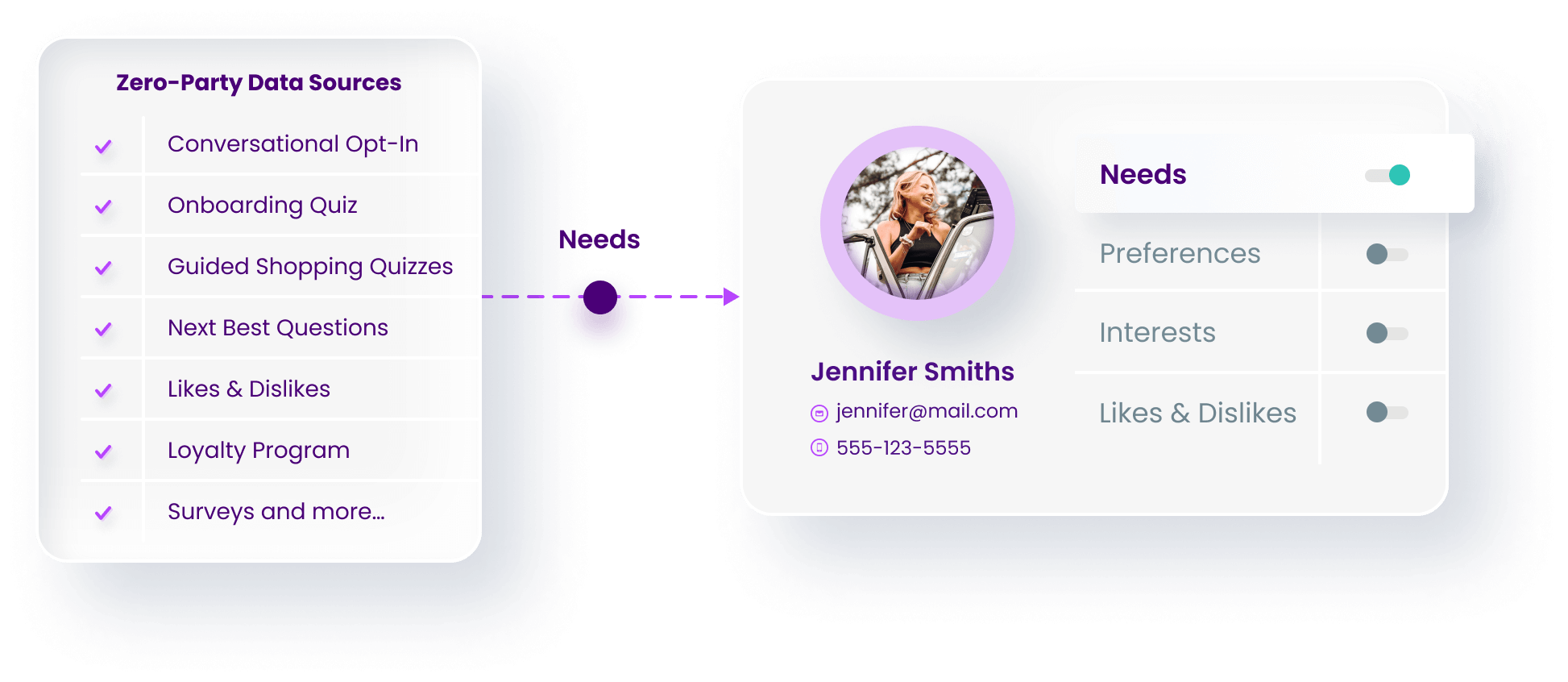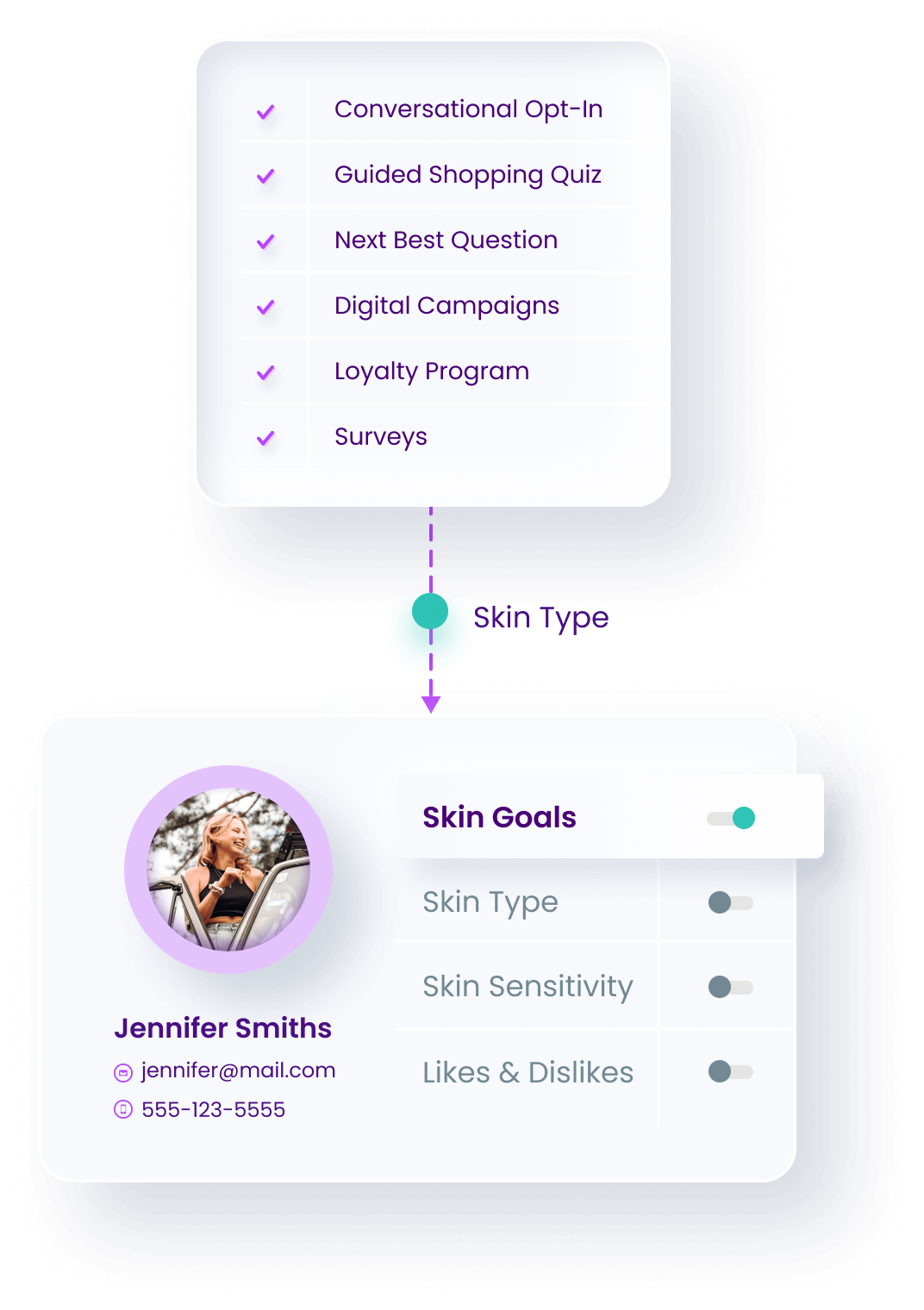
How is your brand responding to the changing attitudes, regulations, and technologies related to consumer data and privacy?
According to Econsultancy, 49% of marketers say zero-party data (ZPD) is their most favored solution. ZPD is all of the consent-based, personal context data that customers intentionally and proactively share with a brand, in order to improve their experience with the brand — personal needs, preferences, interests, favorites, motivations, intentions, etc.
Unlike first-party and third-party data, ZPD is uniquely valuable because it enables brands to deliver customer experiences that are at once welcome, relevant, and compliant — the three pillars of Privacy-First Personalization.
Brands collect ZPD by engaging customers directly and asking them for it, along with permission to use it for specific purposes that benefit the customer. This brings data collection out of the fine print and into the light, upending the old ways of buying data (i.e. third-party) and quietly tracking customer activity (i.e. first-party) behind the scenes.
ZPD is brand-specific, so the first step is to identify the most important customer attributes for your business — not just email or mobile phone opt-ins, but also attributes like goals, preferences, interests, wish lists, and intentions. Some attributes may be immutable or long-lived (e.g. a personal characteristic, or a list of favorites), while others may be shorter-lived (e.g. plans to take a family vacation or renovate a kitchen).
Focus on customer attributes that you can use to improve customer experiences by, say, personalizing the content, products, and offers that you show each customer. Just a single data point can go a long way. For example, when a user tells Yelp that they’re a vegetarian, Yelp can provide them with vegetarian-friendly recommendations rather than steakhouses.
Once you’ve defined your brand’s ZPD data model, it’s time to collect the data.
Get a DemoOften without realizing it, brands have latent ZPD sources they can tap into — like customer surveys, chat bots, loyalty programs, or email preference centers.
By tapping into all of your sources and unifying the ZPD they capture into centralized ZPD profiles, you can keep ZPD organized and up-to-date, make it accessible to your teams and tools, and use it to improve customer experiences.
Specialized ZPD infrastructure software, like the Wyng ZPD API, makes the job easier by streamlining data processing and automating essential functions — like smart merging, cross-session unification, pseudonymization, and ZPD consent management and governance.
Whether you’re starting from scratch or filling gaps in existing ZPD profiles, the “zero-party data formula” offers a systematic approach to creating new ZPD sources:

Forrester Research describes ZPD microexperiences as “short, simple interactions that ask a customer to volunteer three or four bits of information about themselves in context and in exchange for clear value.”
Depending on the target audience, microexperiences can be delivered as:


Why do customers share their personal data with a brand? According to Deloitte, 79% of consumers are willing to share data when they get value in return. And brands can deliver value in multiple ways — both “in the moment” as part of a microexperience, and “in the future” as part of ongoing interactions.
Value “in the moment” may include:
Value “in the future” entails providing customers with more relevant or personalized communications, offers, and recommendations — on an ongoing basis — based on the ZPD they shared with you.
Your microexperiences should clearly explain what types of communications the customer is opting into, how their data will be used, and link to your privacy policy. This is a best practice that meets the criteria of freely given, specific, informed, and unambiguous consent — the highest bar for compliance worldwide, set by GDPR.
It’s easy to create ZPD microexperiences using technology purpose-built for the job, like Wyng Microexperiences. You can also source ZPD by using other tools like a CMS, a survey builder, or a form builder. And as always, make sure every source feeds your centralized ZPD profiles, so you can make the most of the data.
ZPD should be collected and used transparently, and the best practice is for a brand to make the data accessible to each customer on an ongoing basis, via a secure customer portal on the brand’s website or mobile app.
A portal makes it easy for customers to add, update, or revoke data whenever they want, and continually fine-tune their relationship with the brand — giving them transparency, choice, and control, while also building trust.
Brands can custom-build and maintain a portal, or use a ZPD platform like Wyng to streamline the process.
The Wyng platform auto-generates a portal template (based on the brand's ZPD data model), which can be re-skinned to match the brand's design guidelines.
The portal embeds directly into the website (or app), and can sit in front of the site login (whereby access is authenticated via temporary onetime password), or behind site login, depending on the brand's needs.
.png)
.png)




To successfully collect ZDP, first define your brand’s ZPD data model and then start collecting the ZPD you need — by tapping existing sources, adding new sources, and making it easy for customers to keep their ZPD up-to-date.
This is the second in a series of posts about zero-party data and Privacy-First Personalization. Read the first post here: The Future Of Personalization Is "Privacy-First”.
To learn about our API-powered platform for ZPD and Privacy-First Personalization, request a demo below.
We will use this information to contact you and provide any content requested. See our Privacy Policy to unsubscribe or withdraw consent.